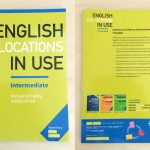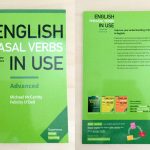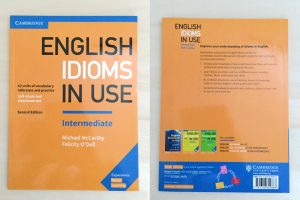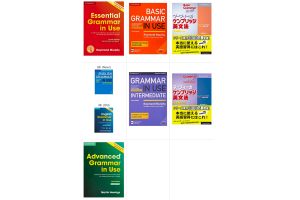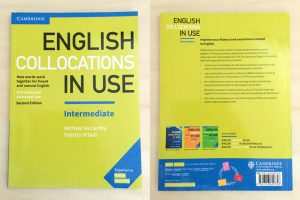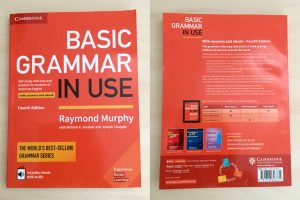【文法書のバイブル! English Grammar in Useシリーズの種類と選び方】も確認する
English Grammar in Useからの句動詞中級
句動詞とは、動詞+副詞や動詞+副詞+前置詞、というように2語以上で構成される動詞のことです。本書はその句動詞を使いこなすための練習本です。全て英語で書かれているため、読むにもある程度の英語力が必要ですが、色々とイメージしやすいイラスト付きです。中級と上級にレベルが分けられていて、本書は中級です。
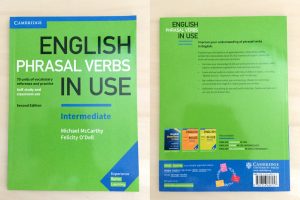
Contents
Acknowledgements
Using this book
Learning about phrasal verbs
1 Phrasal verbs: the basics
2 The meaning of phrasal verbs
3 Particles in phrasal verbs
4 Nouns and adjectives based on phrasal verbs
5 Metaphor and register
Key verbs
6 Come
7 Get
8 GO
9 Look
10 Make
11 Put
12 Take
Key particles
13 Up
14 Out
15 Off
16 On and in
17 Down and over
18 Around and about
19 For and with
20 Through and back
21 Into and away
Concepts
22 Time: spending time
23 Time: passing of time
24 Location
25 Cause and effect
26 Change
27 Success and failure
28 Starting and finishing
29 Actions and movement
30 Destroying and reacting to destruction
31 Communication
Functions
32 Describing people and places
33 Describing public events
34 Describing situations
35 Giving and getting information
36 Solving problems
37 Decisions and plans
38 Disagreeing
39 Persuading
40 Praising and criticising
41 Exclamations and warnings
Work, study and finance
42 The classroom and learning
43 Student life: courses and exams
44 Student life: reading and writing
45 Work: jobs and career
46 Work: being busy
47 Money: salaries, bills, payments
48 Money: buying and selling
49 Business
50 Calling people
Personal life
51 Feelings
52 Relationships
53 Relationships: problems
54 Secrets and conversations
55 Stages through life
56 Health
57 Sport
58 Homes and daily routines
59 Socialising
60 Food and drink
The world around us
61 Weather
62 Travel
63 Driving and cycling
64 Mobile devices
65 Computers
66 News
67 Crime
68 Power and authority
69 American and Australian phrasal verbs
70 Academic writing
Key
Mini dictionary
Acknowledgements
Joy Godwin wrote two new units for the Second Edition: Unit 64, Mobile devices, and Unit 70, Academic writing. The publishers would like to thank Joy for her contribution to this edition. The authors and publishers acknowledge the following sources of copyright material and are grateful for the permissions granted.
While every effort has been made, it has not always been possible to identify the sources of all the material used, or to trace all copyright holders. If any omissions are brought to our notice, we will be happy to include the appropriate acknowledgements on reprinting and in the next update to the digital edition, as applicable.
Key: BL = Below Left, BR = Below Right, CR = Centre Right, CL = Centre Left, TL = Top Left, TR= Top Right.
Using this book
Why was this book written?
It was written to help you improve your knowledge of phrasal verbs in English. Phrasal verbs are verbs which have a main verb and a particle which, together, create one meaning (e.g. a plane takes off from the airport; an adult looks after a child). You will come across a great many phrasal verbs when you listen to and read English, and so it is important that you learn about their meanings and about how they are used. You can use this book either with a teacher or for self-study.
There are more than 5,000 phrasal verbs and related noun and adjective forms in use in English. This book focuses just on those phrasal verbs which you need to know for everyday spoken and written communication in English, and it aims to provide the information and practice which will help you understand and use them correctly.
How were the phrasal verbs in the book selected?
The approximately 1,000 phrasal verbs and related noun and adjective forms which are presented in this book were mainly selected from those identified as significant by the CANCODE corpus of spoken English developed at the University of Nottingham in association with Cambridge University Press, and the Cambridge International Corpus of written and spoken English (now known as the Cambridge English Corpus). You can also find them in the Cambridge Dictionary online by going to the following website:
http://dictionary.cambridge.org
How is the book organised?
The book has 70 two-page units. The left-hand page explains the phrasal verbs that are presented in the unit. You will usually find an explanation of the meaning of each phrasal verb, an example of it in use and, where appropriate, any special notes about its usage. The right-hand page checks that you have understood the information on the left-hand page by giving you a series of exercises that practise the material just presented.
The exercises pay particular attention to checking understanding of the phrasal verbs and how they are used so that you will be able to use them accurately and appropriately.
The units are organised into different sections:
First we start with important information about phrasal verbs in general (Units 1-5): what they are, how their grammar works and so on. This is an important training section, and we recommend you do these units first.
After the introductory units, there are units on the most common verbs which are used to form phrasal verbs (Units 6-12) and units on the most common particles found in phrasal verbs(Units 13-21).
The rest of the book teaches you the phrasal verbs which are associated with particular con (e.g. time), functions (e.g. giving and getting information) and topics (e.g. business, feelings student life).
The book also has a key to all the exercises so that you can check your answers. At the back of this book, you will find a useful Mini dictionary. This provides clear definitions of all the phrasal verbs and related noun and adjective forms that appear in this book. The Mini dictionary also indicates the unit number where you can find a particular phrasal verb.
How should I use this book? It is strongly recommended that you work through Units 1-5 first so that you become familiar with the way phrasal verbs operate and with the terminology that is used in the rest of the book. After that, you may work on the units in any order that suits you.
What else do I need in order to work with this book?
You need a notebook or file in which you can write down the phrasal verbs that you study in this book as well as any others that you come across elsewhere.
You also need to have access to a good dictionary. We strongly recommend the Cambridge Phrasal Verbs Dictionary as this gives exactly the kind of information that you need to have about phrasal verbs, Your teacher, however, may also be able to recommend other dictionaries that you will find useful.
We hope that this book will help you understand and use new or difficult phrasal verbs that crop up (see Unit 44 Student life: reading and writing) in your reading and listening in English and that, by the time you finish the units, you’ll be saying: ‘English phrasal verbs? Show me a new one and I’ll figure out what it means in seconds!’ (see Unit 69 American and Australian phrasal verbs).




